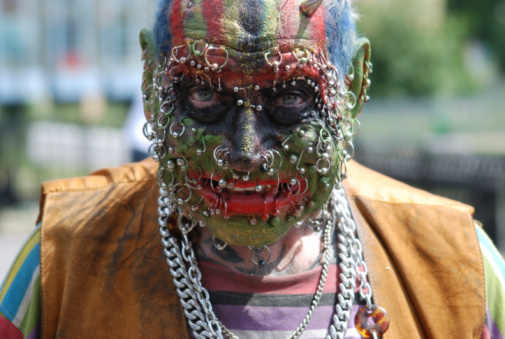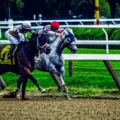Is There a Relationship between Tattoos and Violence?
History suggests that the opposite is true about not only tats but also piercings, ear saucers, nose rings, and general scruffiness.
Judging by news photos and videos, the psychopath who killed and wounded innocent people at the Fourth of July parade in Highland Park, Illinois, resembled a large number of today’s Americans: disheveled, unwashed, and had tattoos on his face and neck.
Surprisingly, he didn’t appear to have accouterments that often go with the look: multiple piercings, ear saucers, nose rings, and hair colored in fluorescent blue and green. Since he was fully clothed, it is not known if his arms, legs, and torso were covered with random and indecipherable tattoos, which also often go with the look.
This isn’t to suggest that people who look like the shooter are psychopaths, or that people who are prim, proper, nattily dressed, and well-scrubbed are not. After all, it’s not as if there aren’t crooks, scoundrels, philanderers, and other moral degenerates at the top of high society, including current and past occupants of Congress and the White House.
Come to think of it, conservatively-dressed leaders of nations have been responsible for killing tens of millions more people throughout history than hipster wannabes or weirdos have ever killed.
De gustibus non est disputandum is an old Latin expression. Roughly translated, it means that there is no accounting for taste. My dorky 11-year-old RAV-4 with the spare tire affixed to the rear end is a case in point. Still, there is something particularly bewildering about what passes for grooming and fashion today.
Making a fashion statement with a tattoo is different in degree and shelf life from the silly fashions of my youth, such as bell-bottom pants, jackets with Nehru collars, plaid suits with four-inch-wide ties, long sideburns, and wingtip shoes with cleats on the bottom that went clickety-clack as I walked through the office authoritatively. When fashions changed, as they always do, I could discard the embarrassments or give them to Goodwill.
On a practical level, it’s unclear how people with a nose ring blow their nose, or whether those with a stud in the tongue or lip have trouble eating. I find that a canker sore in my mouth is uncomfortable enough, and I certainly don’t want to call attention to my Roman nose by hanging a ring underneath it.
Then there is a question of etiquette. Is it proper to look at people with dangles, studs, and skin art or to look away? Do they want to be noticed?
If you look, should you say something complimentary about a person’s tats? If yes, that’s hard to do, because in most cases it’s impossible to figure out what the tats say, represent, or signify. Since skin is the worst canvas for art, especially as it ages, you might end up praising someone for what you think is the likeness of a rat, only to find out that it’s supposed to be an image of a spouse—or Elizabeth Warren.
Speaking of a misunderstanding, when face tattoos were just beginning to appear years ago, a young man walked into a restaurant with what looked like a terrible burn scar on half his face. My feelings of sympathy for the guy turned to bewilderment when I saw that it was a tattoo.
What was the grotesque tattoo supposed to signify? Rebelliousness? Non-conformity? Social class? Gang affiliation? A mental disorder? Bad taste?
Tats were easy to figure out in the blue-collar neighborhood of my youth. Usually, on a bicep, they were small and spelled out “Mom” or “USN” (for US Navy) or the name of a girlfriend or wife. (Women didn’t get tattoos back then.) They also signified social class, because only the working class or the poor had them.
Multiple tats and corresponding adornments now transcend class. Both rich and poor have them, both old and young have them, both criminals and cops have them, both Walmart shoppers and Whole Foods shoppers have them, both celebrities and unknowns have them, both sports stars and couch potatoes have them, both left-wingers and right-wingers have them. Even people who are into organic food and fret about ingesting chemicals have chemicals injected into their skin.
So many people have tattoos that they are no longer a sign of rebelliousness or non-conformity. They now signify the opposite.
The same for the ubiquitous caps worn backward, with the adjusting strap in front and the bill in back, like a duck with his bill on the wrong side of his head. A true nonconformist would wear a cap with the bill in front but wear pants, shirts, and shoes backward.
At the rate that trends are going, someday a US president will sport a tattoo on the forehead: a donkey for a Democrat, an elephant for a Republican, a MAGA for Donald Trump, and a red star for Bernie Sanders and AOC. Depending on your politics, you might be thinking that a rat would be more appropriate.
Another popular fashion statement is the scruffy look of an untrimmed beard, scraggly and unwashed hair, and, most puzzling of all, jeans that come new with rips in them. At least when the flower children and peaceniks of the late 1960s and early 1970s looked like that, they were making a political statement. It’s hard to say what the statement is today. Maybe it’s a statement of affluence, or maybe it’s simply the influence of celebrities.
It makes one wish for the celebrities of yesteryear, such as Cary Grant, Fred Astaire, Ginger Rogers, Nat King Cole, Jimmy Stewart, Julie Andrews, and Louis Armstrong. Whatever their private peccadillos might have been, they were models of savoir-faire, modesty, decorum, and manners.
Is there a relationship between today’s shootings and today’s tats, piercings, nose rings, and scruffiness? I’d like to make the affirmative case but can’t. That’s because American history of the twentieth century includes the violence of Jim Crow, the violence between management and labor during the labor movement, the violence of the anarchist movement, the violence caused by Prohibition, the violence of the Weather Underground, and the violence of the Black Panthers—all of which took place prior to the current fashion.
Then there was the 1927 bombing of a school in rural Bath Township, Michigan, where 38 children and six adults were killed and 59 more were injured. The carnage would’ve been much worse if it were not for many of the explosives failing to detonate. The bomber, Andrew Kehoe, was a 55-year-old farmer, school board treasurer, and former township clerk. He didn’t have neck tattoos or a nose ring, but perhaps his cattle wore brands and nose rings.
Maybe the relationship goes in the other direction. Maybe the more tats, piercings, nose rings, and scruffiness, the less violence. If so, maybe I can learn to like the look. As a first step, I’ll stop washing my hair.



